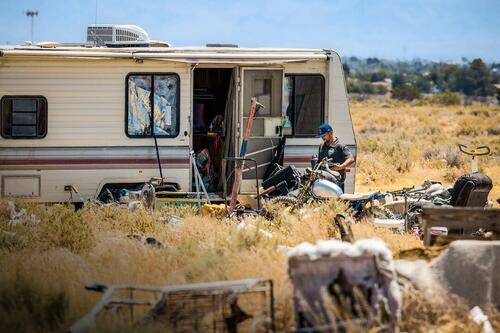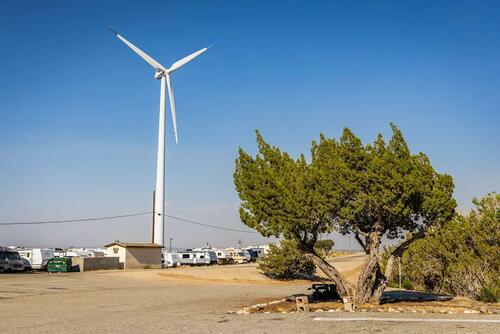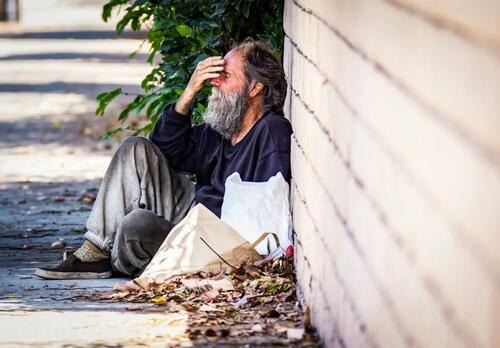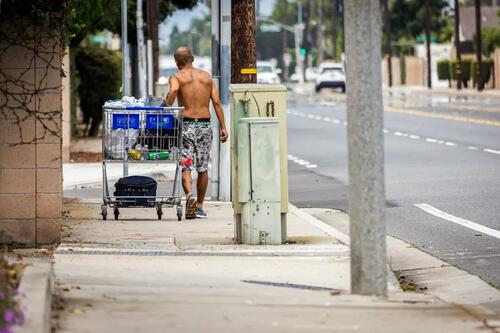Authored by Beige Luciano-Adams via The Epoch Times (emphasis ours),
In the scrubby Mojave desert north of Los Angeles, a sprawling encampment of decrepit RVs sits just off a dirt road separating the city of Lancaster from Los Angeles County’s unincorporated expanse.
 A homeless man lives in an old RV that sits in the Mojave desert, near Lancaster, Calif., on July 10, 2024. (John Fredricks/The Epoch Times)
A homeless man lives in an old RV that sits in the Mojave desert, near Lancaster, Calif., on July 10, 2024. (John Fredricks/The Epoch Times)In every direction, garbage spreads out like an algae super bloom—beyond that, endless sand and brush, baking in the summer sun.
“Keep your head on a swivel for dogs,” a member of the city’s public safety and emergency response unit tells us. Through the haze, we see two pit bulls and a German Shepherd under a tarp, but they are tethered, too hot to move.
Freddy, a resident, seems only moderately bothered by the 110 degree temperature. “I don’t have a car anymore, so I can’t get my own water,” he says, when asked how he survives out here.
“Someone brings me water every two weeks,” he said, referring to a nonprofit.
Pointing down at his legs, scaly and engorged beneath black shorts, he adds, “And I’m sick, too. They bring me medicine.”
There is no grid here, no power or water. RV residents dump their raw sewage in the desert, either right outside their vehicles, or sometimes with a hose that carries it a little farther out.
Such encampments, which are also a magnet for illegal construction dumping, appear as clusters on satellite maps, dotting the rugged terrain just past the county line. Officials say they stretch out as far as 10 miles into the desert, but most stay closer to town.
Freddy is one of thousands without housing in the northern part of the county, according to data released last month by the Los Angeles Homelessness Services Authority (LAHSA).
On any given night, an estimated 6,672 people are homeless in the Antelope Valley—a 42 percent increase over the year prior. But only 1,057 of the region’s homeless people live in its two main cities, Lancaster and Palmdale, leaving the remaining 5,615 in smaller towns and the region’s rural unincorporated areas.
It’s surprising that so many people could be living in tents, under tarps, inside of old RVs, out in the middle of the high desert with no water or infrastructure.
But those familiar with the situation say the population was already high, and the dramatic jump simply represents a more thorough count this year.
“The count went up this year because the count was done wrong in previous years,” said a city official, who asked not to be identified by name. “This year we utilized a drone, and our teams went out to remote areas and did the count,” he said, estimating the actual increase over last year might be closer to 25 percent.
L.A. County Supervisor Kathryn Barger, whose 5th District includes the Antelope Valley, also suggested the increase may not be as straightforward as it looks.
“The Point In Time Count is not a perfect science and it’s rightfully evolving,” she said in an email to The Epoch Times, expressing uncertainty over whether the number reflects an increase or a better count.
 A wind turbine system outside of Palmdale, Calif., on July 10, 2024. Palmdale’s homeless count rose from 177 in 2023 to 537 in 2024. (John Fredricks/The Epoch Times)
A wind turbine system outside of Palmdale, Calif., on July 10, 2024. Palmdale’s homeless count rose from 177 in 2023 to 537 in 2024. (John Fredricks/The Epoch Times)“Regardless, we will use those results to draw down more federal and state funding so that we can deliver more local housing and shelter options. The need in the region is real.”
Either way, the uptick is an outlier in 2024, when the county overall and most city homeless populations are either remaining stable or shrinking slightly.
The City of Lancaster’s overall homeless count went down in 2024, to 520 people from 590 the year prior, with fewer unsheltered homeless and more sheltered homeless individuals. Palmdale’s, meanwhile, rose from 177 to 537.
Inquiries to Palmdale city officials, including the mayor and city councilmembers, were not returned.
LAHSA also did not respond to a request for comment on the increase in the homeless population in Antelope Valley.
While many municipalities across the West stopped clearing homeless encampments after a series of Ninth Circuit Court decisions determined anti-camping laws violated the Eighth Amendment, Lancaster bypassed those restrictions with procedural caveats, by offering shelter before moving people.
Since the Supreme Court reversed the lower court rulings earlier this month, officials say, enforcement is easier.
Critics of such enforcement, such as the ACLU, have long argued Lancaster is pushing people who have nowhere to go into dangerous, extreme conditions. But officials say there are beds available, and enforcement is attended by offers of services and shelter.
So why are thousands of people homeless in the desert?
End of the Line
Lancaster Mayor Rex Parris, an outspoken critic of what he says is the county’s neglect of the region, allows there are various factors that might contribute to an increase in homelessness—former inmates at California State Prison, in Lancaster, who end up in the community without services, along with a small percentage of people losing housing or falling on hard times.
Lancaster has always been a far more affordable bedroom community, but median rent is currently $2,595 a month—only about $200 cheaper than Los Angeles, according to real estate website Zillow.
But the main reason, Mr. Parris told The Epoch Times, is L.A.’s systematic tendency—not a conspiracy, exactly, more like a default setting—to send its problems north.
“I think it’s tied to the L.A. area pushing them up here,” he said of the homeless count increase. “They tend to push all of their problems up here, if they can. And now you’ve got the World Cup, and you’ve got the Olympics coming, and they’re in a mad rush to get rid of their homeless, and so they encourage them to come here.”
Mr. Parris says his teams are “constantly interviewing people who were given a ticket and told, “go to Lancaster, we’ll feed and take care of them,” but did not specify by whom.
“It’s at the end of the Metro line, literally. This is not unusual.”
The county’s transit system, plagued by violence in recent months, has its own problems. Used as a de facto shelter by thousands during the day, its buses and trains are emptied for cleaning each night, which some end-of-line cities say has resulted in sharp increases in their transient homeless populations.
Lancaster, 60 miles north of Los Angeles and at the very end of the Metro transit system, is far more remote than other such cities.
 (Top) A homeless man walks with his belongings along a street in Santa Ana, Calif., on July 15, 2024. (Bottom) A homeless individual rests by a busy street in Santa Ana, Calif., on July 15, 2024. (John Fredricks/The Epoch Times)
(Top) A homeless man walks with his belongings along a street in Santa Ana, Calif., on July 15, 2024. (Bottom) A homeless individual rests by a busy street in Santa Ana, Calif., on July 15, 2024. (John Fredricks/The Epoch Times)Lt. William Kitchin, who oversees the Los Angeles Sheriff’s Department’s (LASD) homeless outreach team for the entire county, said he has not personally seen evidence to support the idea that people are being directed to the region, but has observed migration to end-of-line cities.
However they end up there, once in Lancaster, civil rights groups say, authorities have routinely pushed homeless people out into the desert.
In a study based on interviews with 53 unhoused people in and around Lancaster from February 2019 to October 2020, the ACLU claimed the LASD “banished” people to remote county areas, combining the threat of criminal and civil sanctions with “suggestions” to leave town.
Such claims, the lieutenant said, are easily disproved by body cameras that record deputies’ interactions when enforcing local ordinances.
Lt. Kitchin’s team works with LAHSA to resolve encampments of more than five people, and he said such operations are always done with advance notice and offers of services and housing.
“We can’t dictate or tell people where to go. We just say you can’t be here. We prefer you take the services that were provided, so you can go inside and get your life started on the right track, but we can’t force them into it,” he said.
Starting on July 22, his team plans to clear desert encampments in an area north of Lancaster and place an estimated 40 people in hotels as part of the county’s “Pathway Home” program.
“Prior to the pandemic,” the lieutenant said, “what we used to see is that people who were homeless in that area either grew up there or had roots there, parents or family. Now we’re seeing more people from out of state.”
Officials who asked not to be identified by name said they see a constant influx of new faces in Lancaster and the surrounding area. “We know everyone here and everyday we’re seeing new people. It’s not people losing their homes, there’s some of that, but mostly it’s not. They came from somewhere else, they moved here,” one said.
The city’s team has access to five beds for immediate shelter. After two weeks, they move people to Kensington, Lancaster’s sprawling homeless housing campus—so those five beds always stay open for people who might need them, officials said.
Mayor Parris told The Epoch Times that beds remain open at Kensington throughout the year, except when extreme weather drives occupancy up.
Opened in 2019, the campus has 153 interim beds and 150 permanent supportive housing beds, and receives more referrals than it has availability, a representative for A People Concern, the organization that operates the campus, told The Epoch Times in an email.
The representative said they are currently “nearing capacity,” with a “fluctuating occupancy as individuals may choose to transition between programs.”
 Michael, a homeless man, passes by an area with tents housing the homeless, near Lancaster, Calif., on July 10, 2024. (John Fredricks/The Epoch Times)
Michael, a homeless man, passes by an area with tents housing the homeless, near Lancaster, Calif., on July 10, 2024. (John Fredricks/The Epoch Times)Mr. Parris draws a hard line between what he characterizes as a minority of the homeless population in his city, who have fallen on hard times or been pushed out of housing—and an overwhelming majority, who refuse housing and choose the streets and drug abuse as a lifestyle.
“I was a drug addict, and I have been homeless. And I have been in jail,” Mr. Parris, a lawyer, said. “So none of this is foreign to me. You know, I think I probably have a better understanding of it than most. But I know the difference between a looter and someone who needs help—and wants help.”
Read more here...
Source link


